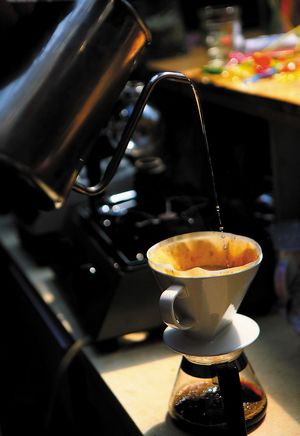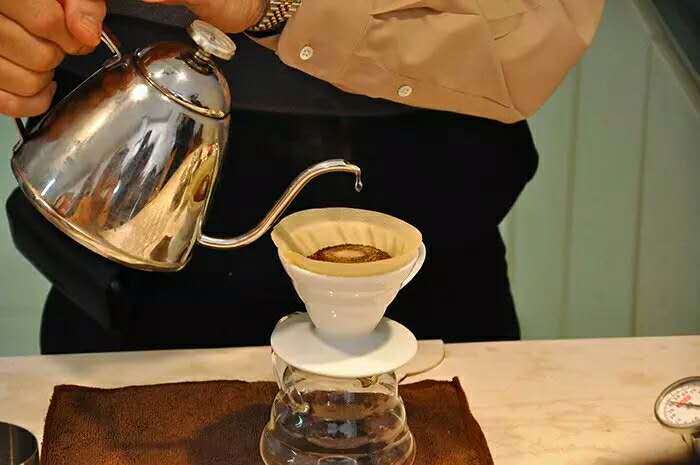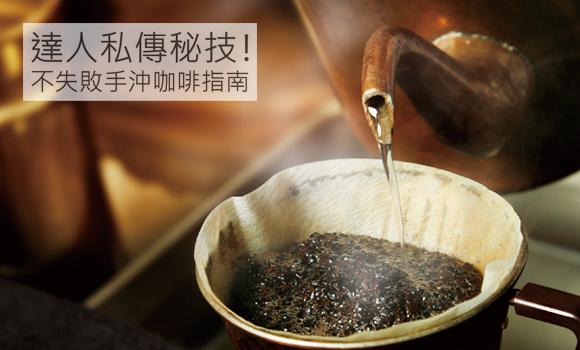Detailed introduction of the concentration of Espresso
Professional coffee knowledge exchange more coffee bean information please follow the coffee workshop (Wechat official account cafe_style)
When talking about "strength", you may be talking about one of the following three things:
Flavor intensity
Texture, weight, or viscosity
Concentration of soluble flavor substances in coffee
These three often appear in the same sentence. To avoid confusion, I would like to make the following definition here:
When I use "strength", I use "strong" and "light" to indicate the concentration of soluble flavor substances in coffee, or TDS (total soluble substances). When I use "intensity", I'm talking about flavor intensity. When I use "rich", "watery", "heavy" and "light", I'm talking about texture, weight and viscosity.
Concentration Strength
In order to communicate the concentration quickly and effectively, we express the concentration as a percentage relative to the whole cup of coffee. The vast majority of espresso concentrations are between 7% and 12%, which means that 88% of them are water. The concentration of dripping coffee is generally between 1.2% and 1.8%, that is to say, 98.2% to 98.8% is water.
"98.8% is water?!" You asked. AHA, yes. Water is the most important ingredient in coffee, but it is certainly not the most prominent ingredient. Coffee is a medium with strong flavor, and a slight change in its concentration will be detected by our sense of taste. For anyone with taste buds, a 0.1% change in coffee concentration can be detected. That is to say, the experience of 7% and 12% espresso is a completely different world.
Concentration plays two major roles in the process of drinking coffee, one is the intensity of flavor, the other is the texture, weight and viscosity of coffee.

Strength Intensity
A cup of espresso is 10 times stronger than a cup of filtered coffee. This almost ensures flavor enhancement because there are more than 10 times as many flavor compounds hitting your tongue. Although this growth is not as simple as turning on and off lights.
Concentration also affects our perception of flavor. When the concentration increases, our ability to perceive the flavor of coffee decreases significantly. When the concentration is high, the perceived flavor intensity of coffee increases rapidly. Even if the coffee contains the same flavor substances, when the concentration is different, your taste perception is also very different.
Light coffee is not necessarily watery or boring. Sometimes, the lower concentration of coffee can also make our taste enjoy more flavor that is not easy to detect at the higher concentration. A lighter and more refined espresso is less intense and sometimes easier to taste than a strong espresso.
Stronger espresso will affect our ability to taste the natural flavor of coffee. The best example is to use a traditional "Italian" deep-baked bean to extract a cup of espresso with a short time and high concentration, and then dilute it to different concentrations with water. At the initial high concentration, you may mistakenly think that the baking degree is not deep. Once diluted, it is easy to drink flavors that are produced by baking but are not previously obvious.
In a certain concentration, no matter what kind of coffee or how it is extracted, it will be so bitter that there will be no friends. Unfortunately, tongues have not evolved to be able to taste highly concentrated liquids. If you are wondering whether a cup of espresso that tastes bitter is too strong, you can test it by diluting some of the coffee with water. If the bitterness goes away, the concentration is the culprit. If it is still suffering, it is caused by other reasons.
Texture, weight and viscosity
Touch is one of the important elements of a good cup of coffee. When drinking coffee, everyone expects a certain degree of texture, weight and body feeling. These preferences may vary depending on region and culture, but if it is a good espresso, to be fair, it should be sticky and round. A cup of filtered coffee should also have a certain amount and texture to be different from the tasteless water.
I have a list of words to classify the concentration of coffee, from weak to strong. Some words can also be used to describe flavor intensity, but the following words and the order in which they are displayed are only used for texture, weight and body sensation caused by concentration.
These words are not exhaustive yet, but they already provide you with a wide range of words to describe the concentration of any coffee you encounter.
Optimal concentration
The optimal concentration is hard to define, like most of the subjective aspects of coffee. Everyone wants their drinks to be different. Take myself as an example, the ideal concentration means full taste, but it will not steal the limelight of the flavor. The following is my preferred concentration range:
It would be right if the concentration of espresso,TDS is between 7.5% and 9.5%. A higher concentration than this will only make my head feel bitter. Lower than this, you are in the concentration range of 2% color 7%, and the flavor wants to be hidden (but also delicious). No matter how to extract coffee, it is difficult to define whether the coffee in this range is drip filtration or espresso. If your espresso's TDS is less than 7%, it's best to communicate the expected texture of the coffee before the customer tastes it.
If it's dripping coffee, I like it when TDS is between 1.3-1.7%. Less than 1.3% won't satisfy me. This kind of coffee lacks stickiness, which makes me want more flavor. The coffee around 2% also let me down. I think, with the change of coffee concentration, the taste has its ups and downs, while 2% is at a low ebb. It's too strong for dripping, but not strong enough for a good cup of American coffee.
Experiment is king, as always. I think it is extremely important for all baristas to learn and test concentration as an independent variable.
Related readings:
How to make espresso Coffee
There are four principles for Italian extraction of espresso:
1. An excellent barista
2. Appropriate grinding fineness and powder content
3. High quality blended coffee beans
4. Stable coffee machine.
Therefore, if you want to make your own cup of espresso at home, you must have a reliable coffee machine, including mellow fresh coffee beans, Italian bean grinder and Italian coffee machine. extraction technology requires more practice and improvement to master, here, the most important thing is to talk about the choice of home coffee maker.
There are two main types of coffee machines that can extract espresso: Italian machine and mocha pot, while Italian machine includes semi-automatic Italian machine, fully automatic Italian machine and capsule coffee machine.
Semi-automatic coffee machine
The price of the semi-automatic coffee machine is relatively low, ranging from hundreds to thousands, and it needs to grind, powder, fill, extract and foam on its own, which is suitable for enjoying the process of making coffee, and friends who like to study different extraction methods and different tastes start with recommending a machine of about 1000 yuan, which is suitable for stable output of 9Bar pressure (some false 15Bar pressure is of no use)
Fully automatic coffee machine
The price of a fully automatic coffee machine ranges from two or three thousand to ten or twenty thousand. Basic enthusiasts can make a perfect Italian concentrate, just put in fresh coffee beans at once and get out of coffee with one click, eliminating all intermediate operations (not even a bean grinder). Automatic milk foam function allows you to easily make a cup of latte, the focus is easy to clean, durable and stable
Capsule coffee machine
Capsule coffee machine is a new extraction method in recent years, which has the advantages of compact and beautiful, easy to operate and no cleaning, and the price is basically about 1000 yuan. Each extraction only needs to put in a sealed coffee powder the size of jelly. Then you can enjoy the fragrant coffee in a few seconds, but the disadvantage is that the cost per cup is high (the price of a single capsule is about 5 yuan), and most must use matching coffee capsules.
Mocha pot
Mocha pot has a long history, almost every family abroad must have a mocha pot, the price varies from one hundred to three hundred, you can use gas, induction cooker and other heat sources to heat, this is a very magical coffee pot, although the extraction pressure is very low, but it can also extract CREMA like Italian machine, delicious taste, and then cooperate with manual milk bubble can also make delicious latte!
Important Notice :
前街咖啡 FrontStreet Coffee has moved to new addredd:
FrontStreet Coffee Address: 315,Donghua East Road,GuangZhou
Tel:020 38364473
- Prev

What is the future of barista industry and whether it is worth developing
Since the reform and opening up, with the improvement of people's living standards and the deepening of exchanges between China and western countries, the coffee industry has accelerated its development. Coffee chain stores of world famous brands have entered the mainland of China one after another to seize Chinese cities
- Next

Taiwan's got Talent privately pass on secret skills! Do not fail to make coffee by hand
Professional baristas Please follow the Coffee Workshop (official Wechat account cafe_style) when it comes to coffee beans, they can be divided into light roasting, medium roasting and heavy roasting. Coffee cherries are actually like fruits. Good coffee beans have fruity, floral, cocoa, nutty flavors, etc., usually the lighter the roast and the more sour they are, the more they can drink the essence of the coffee beans; on the contrary, the heavier the roast, the more bitter. Just brew.
Related
- What is the meaning of lactic acid fermentation with coffee bean treatment?
- How to judge the state of foam by sound?
- How does the latte pull out the unicorn pattern? Come to get for a little trick to improve the flower pull!
- Will flower pulling affect the taste of the latte?
- Do you know the history of coffee?
- The difference between honey treatment and sun washing what is raisin honey treatment?
- What kind of milk can a novice use to make coffee foam to keep the foam longer? The correct method and skills of milking tutorial sharing
- Why do washed coffee beans taste sour? Flavor characteristics of washed Coffee
- Introduction to the skill of how to practice the size and height of water injection around the circle of hand-brewed coffee
- How do beginners practice coffee flower drawing from scratch?

